What Caused the Timberwolves’ Collapse Against Boston?
Having fallen short of expectations so far this season, a win over a finals contender could be the first step towards a lengthy midseason win streak. They got the opportunity against Boston on December 23rd. The Wolves were .500 going into the matchup but have naturally struggled against good teams. They were just 9-12 against teams over .500 compared to 7-4 against teams under .500. They played the Celtics evenly through three quarters, just two points behind going into the fourth. Hope of a victory evaporated quickly. The Celtics took control in multiple ways and won the game 121-109. What caused the Timberwolves’ fourth-quarter collapse?
A Quick Synopsis of the Timberwolves’ Collapse in the Fourth Quarter
There were 21 possessions in the fourth quarter (before the benches subbed in). They turned the ball over four times in those 21 possessions, good for a 19% turnover rate. The league average is 14.7%, so it’s fair to say turnovers contributed to the collapse. They shot just 7/16 from the field, including 1/6 from three-point land. The Celtics grabbed four offensive rebounds to the Wolves two.
Turnovers Plagued the Timberwolves
Naz Reid committed two of the four fourth-quarter turnovers in quick succession.
The first was in the midst of a rare Wolves ball movement. Attempting to pass out of a drive where he was able to drag Celtics defenders in, he airmailed the pass to Austin Rivers. Rather than having an open three, he turned it over. It’s difficult to pinpoint what went wrong during the possession. Reid was actually making a nice play off of a closeout. Jaylen Brown‘s stunt did manage to help stop Reid’s drive, but it did not have much effect on the pass. Reid followed that turnover up with a charge on the next play. Because of a dribble hand-off with Rivers, Reid could get Derrick White switched onto him. Attempting to take advantage of the size mismatch, Reid elected to use brute force over footwork. It was an easy call. The other two turnovers were off of lobs.
Attempting to feed Rudy Gobert on a pick-and-roll, D’Angelo Russell didn’t put enough air under his pass, and Luke Kornet snagged it. He could’ve risen up for a floater with Kornet playing deeper to take away the lob, but it’s hard to pick a primary factor in the turnover (the pass or the defense).
Anthony Edwards was ready to hammer down a transition lob before old man Al Horford broke it up. The Wolves had numbers, and the turnover led to an easy cherry-picked bucket for Jaylen Brown.
The Inefficiency and the Defense
Jaden McDaniels single-handedly kept the Wolves alive through the first few minutes. Through their motion offense, McDaniels took multiple defenders to the rim for tough finishes and even made some pull-up twos. He was working off the catch but also had a nice rollout of a screen on one play. He played his role defensively, as well. Starting out against a small-ball lineup of Derrick White-Malcolm Brogdon-Jaylen Brown-Grant Williams-Luke Kornet, his perimeter defense was an intuitive fit.
The small lineup meant Gobert had to play awkwardly on some possessions. Unable to capitalize on any offensive mismatches, despite working hard and holding position in the paint, he was too sluggish to keep up with the small and shifty Celtics lineup.
Everyone knows D’Angelo Russell plays through polarizing hot and cold streaks. This quarter was a wonderful representation of a cold streak. When the Wolves were down 94-102 and going into their ninth possession, he wanted to take things into his own hands. Sometimes he dazzles; sometimes, he drizzles. The isolation possession began at the top with White on him. Russell failed to gain a single step but pulled the trigger and attempted a shot. White effortlessly blocked it, though he did receive some help from Jayson Tatum. McDaniels looked to be dozing off in the short corner, allowing Tatum to step up without any fear of McDaniels countering. The tenth possession was no better. Grant Williams was tasked with covering Edwards, and Edwards chucked up a step-back three.
An Attempt to Correct
Chris Finch called a timeout with 6:48 left, and the immediate offensive play saw four quick passes on a well-timed offense. Russell got it started with a pass to Reid, and he made an anticipation pass to Edwards coming off a Rivers screen. The Celtics were moving well, arriving at each defender as the ball did, but Russell sabotaged the possession. He spotted up on the right wing, received the pass, and pulled the jumper with Horford in his face the whole way. The abrupt stop to the offense was unnecessary, as there was still plenty of time on the shot clock. Gobert managed to corral the rebound and find McDaniels for a dunk attempt which led to two free throws.
The majority of the following possessions were equally as frustrating as the prior three. Light crossovers and hero-ball three-pointers were the plays of choice. Little to no ball movement, with a Celtic able to disrupt timing and flow.
The Rebounding
The four offensive rebounds weren’t as irritating. Reid was too lethargic and gave up positioning to Luke Kornet, and he positioned himself just a foot or two off on a weird bounce. Otherwise, the offensive boards weren’t out of the norm. Considering the distances they were shot from, the Celtics were bound to grab some of them.
The Timberwolves Couldn’t Get a Stop
The Celtics’ shot quality was leaps and bounds better than the Wolves. Rather than settling for contested threes off of poorly spaced spot-ups, they always had clear looks. The aforementioned small lineup allowed the Celtics to manipulate space with Gobert. He gave up a backdoor layup to Brown and struggled to find a home in the paint with the Celtics moving the ball around the perimeter. The 11th possession exemplified their ability to control the Wolves’ defense.
With the ball on the left wing and Gobert guarding a man in the right corner (the weakside here), he was in a position to help. One quick and simple pass to Marcus Smart between the right wing and the top grabbed Gobert’s attention and prevented him from playing in the paint. After making the pass the Smart, Tatum made an assertive backdoor cut and promptly received the nifty behind-the-back bounce pass from Smart.
The most important note about that pass was not how pretty it looked. Rather, it was anticipatory. Smart wasn’t simply given a turn with the ball. He was given an option to do something with it, which was Tatum making a quick cut with the best rim protector mitigated. The play happened so fast that Gobert could not rotate into the paint. Considering just a fraction of a second before the score, he was assigned to the strongside and, therefore, unable to shade down without leaving a dangerous shooter just one pass away (Grant Williams). The Wolves were slow to get back on defense, too. Even after making a layup after an Edwards drive, the Celtics scored a quick fastbreak-style score before any of the five Wolves made it back.
The Last Word on the Timberwolves Collapse
Taking low-percentage shots while allowing high-percentage shots is a recipe for something nasty. Nothing the Celtics did is too complicated for the Wolves to recreate. It’s just one-quarter of one game, and it’s easy to overreact. However, glaring issues remain. The offense was stagnant and predictable. The defense was out-schemed. It will happen again. Whether or not a change occurs in how that next crucial quarter is played is yet to be seen.
The only positive takeaway is that the issues have been addressed. It’s time to correct them. That’s basketball.






